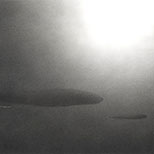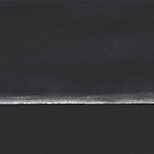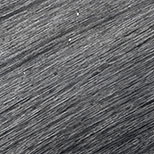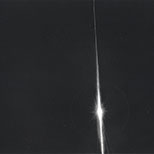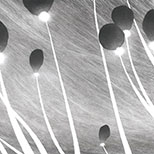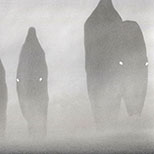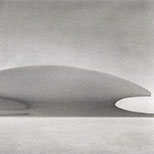
Jorge Alegría
Essay by Susie Kalil
In Jorge Alegría's universe, the forces of order and the forces of chaos are locked in struggle. The War of the Angels is an alternative creation myth, a new story of how the cosmos and all that dwells in it came to be. Alegría's epic series presents a futuristic vision of a pluralistic world that is light years away. Evocative of Star Trek, Star Wars, Blade Runner, Aliens and other sci-fi movies, comics or graphic novels that similarly take a mythic approach to fabulizing the future, the small drawings are finely attuned to place and atmosphere.
The "war" that is called into being is dark and dystopian, yet induces visions of dreamlike intensity. There is something gripping and immediate about Alegría's intimate works, which use cotton pads, brushes, stencils, graphite powder and all manner of pencils to create microcosmic worlds within macrocosmic stretches of space. They grab us viscerally, yet insinuate a poetic understanding of the plight of souls. As Alegría tells it, The War of the Angels begins during the story of Noah, with lives and animals relocated and dispersed throughout a star system in which other civilizations and angels rise and fall over the millennia. When a distant angel seeks revenge, all humankind and other beings, earth and colonized planets, become threatened by terrorism. More than simply an expression of craft and virtuosity, Alegría's reservoir of ideas is generated by a steady stream of consciousness, an intuitive lateral thinking process that runs continuously back to boyhood interests: dinosaurs, Bible stories, ant farms, bird watching and fantasy books.
As an adult, he began to question the systems of order we impose on the world. By confronting catastrophic situations where they break down—9/11, ISIS—he reveals how fragile reality is, how disconnected we have become from grace and redemption in an unsettled era of spiritual malaise. All of the drawings are imbued with melancholy, mystery, a sense of foreboding, or a psychological and symbolic dimension that captures complex moods and states of being. An abyss of velvety black sky and eerily luminous worlds beyond evoke primal forms of escape and finality—at once total submersion as well as abandonment, loss and ultimate desolation. Surveying this never-neverscape are the dark angels, like ominous foes detected from the deck of Starship Enterprise. Giant mounted proto-spiders and shadowy beings float from place to place and seem to inhabit as much an internal as external realm. The cosmos feels like it is coalescing at the same time it could dissolve.
It's a striking paradox then, that despite the intent, Alegría's work—through its exploration of meaning and faith—also reminds us of the failure inherent within those belief systems. In other words, when the present is obscure and alien, the future can look like home. Alegría makes us stare into that unthinkable void of space and time.
Jorge Alegría has continued to produce and exhibit his work for over two decades. In 2003, he and David Hill started the independent art space, Residence. Revived in 2013 as The Living Room, Alegría featured one-night shows of his new work and selected artists. In recent years, his drawings and paintings have been included in solo and group exhibitions and art collections across Texas including Presa House Gallery, Texas A&M-Corpus Christi, Rockport Center for the Arts, Southwest School of Art, and the Art Museum of South Texas. Alegría currently lives and works in his hometown of Corpus Christi.
Group exhibition: Redux Summer Selection
Group exhibition: Prohibitor
Solo exhibition: Supernova
Group exhibition: Slipstream: Curated works by Susie Kalil
